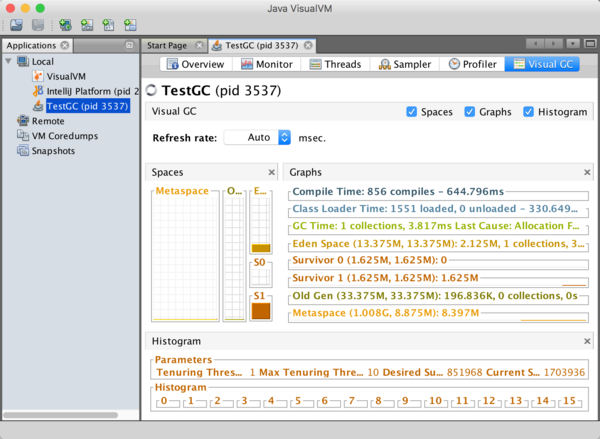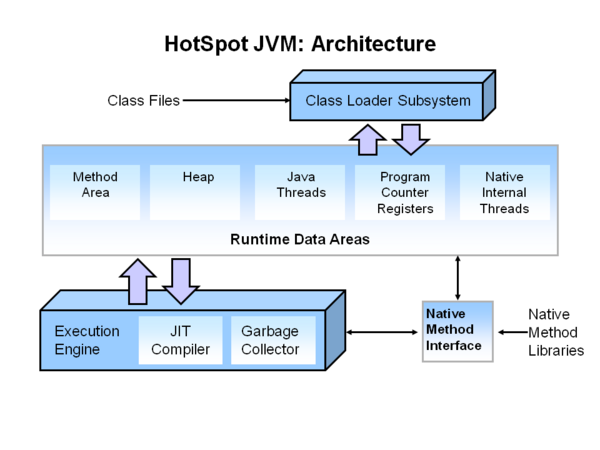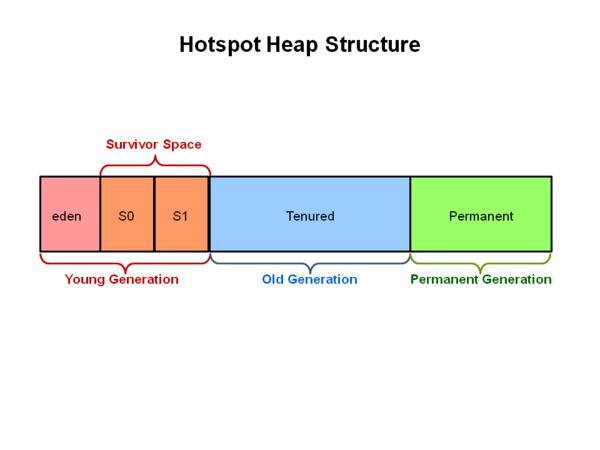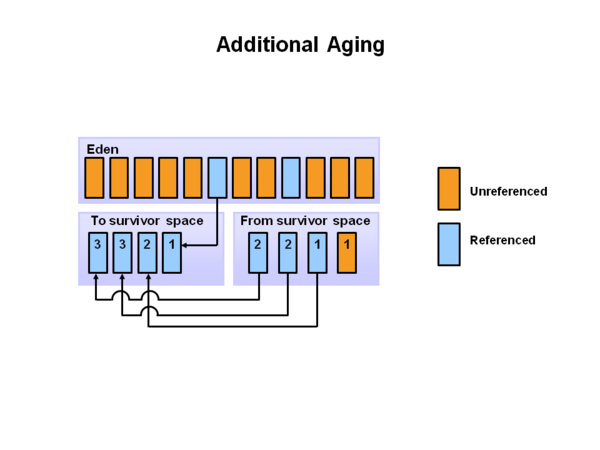imported>Riguz {style="width:400px"} |
无编辑摘要 |
||
| 第1行: | 第1行: | ||
[[File: | [[File:Hotspot-Arch.png|600px|HotSpot JVM architecture]] | ||
= JVM Generations= | = JVM Generations= | ||
[[File: | [[File:Hotspot-heap.png|600px|Hotspot Heap Structure]] | ||
Java的堆被划分成不同的区域: | Java的堆被划分成不同的区域: | ||
| 第15行: | 第15行: | ||
其中,yound generation 又被划分成Eden space, Survivor Space1, Survivor Space2,其中Eden Space占了绝大部分的空间。当Eden space满的时候,GC 会将存活对象移动到其中一个Survivor Space中,两个Survivor Space是为了避免内存碎片,每次将存活的对象(Eden Space以及上一个Survivor Space)移动到另一个Survivor Space中。 | 其中,yound generation 又被划分成Eden space, Survivor Space1, Survivor Space2,其中Eden Space占了绝大部分的空间。当Eden space满的时候,GC 会将存活对象移动到其中一个Survivor Space中,两个Survivor Space是为了避免内存碎片,每次将存活的对象(Eden Space以及上一个Survivor Space)移动到另一个Survivor Space中。 | ||
[[File: | [[File:Hotspot-Aging.png|600px|Mnior GC]] | ||
通过Java VisualVM和VisualGC插件可以很直观的看到GC的过程: | 通过Java VisualVM和VisualGC插件可以很直观的看到GC的过程: | ||
| 第93行: | 第93行: | ||
* [https://www.oracle.com/webfolder/technetwork/tutorials/obe/java/gc01/index.html Java Garbage Collection Basics] | * [https://www.oracle.com/webfolder/technetwork/tutorials/obe/java/gc01/index.html Java Garbage Collection Basics] | ||
* [https://www.oracle.com/webfolder/technetwork/tutorials/obe/java/G1GettingStarted/index.html Getting Started with the G1 Garbage Collector] | * [https://www.oracle.com/webfolder/technetwork/tutorials/obe/java/G1GettingStarted/index.html Getting Started with the G1 Garbage Collector] | ||
2021年4月30日 (五) 14:16的版本
JVM Generations
Java的堆被划分成不同的区域:
- young generation:存放新创建的对象,当这个区域占满的时候,会触发minor GC,这时候存活的对象会被标记年龄,最终会移动到old generation。
- old generation:存放存活的比较久的对象。当yound generation存活的对象年龄到达设置的阈值后,就会被移动到这里来。当这个区域满了的时候,会触发major GC。
- permanent generation:存放一些JVM运行所需的元数据,例如类的信息等。full GC的时候也包括对这个区域的GC。
其中,minor GC和major GC都是Stop the World的,即当GC触发的时候,所有的程序线程都会停止等待GC完成。通常minor GC会比major GC快很多,因为major GC会遍历所有的存活对象。
其中,yound generation 又被划分成Eden space, Survivor Space1, Survivor Space2,其中Eden Space占了绝大部分的空间。当Eden space满的时候,GC 会将存活对象移动到其中一个Survivor Space中,两个Survivor Space是为了避免内存碎片,每次将存活的对象(Eden Space以及上一个Survivor Space)移动到另一个Survivor Space中。
通过Java VisualVM和VisualGC插件可以很直观的看到GC的过程:

java -Xmx50m \
-XX:-PrintGC \
-XX:+PrintHeapAtGC \
-XX:MaxTenuringThreshold=10 \
-XX:+UseConcMarkSweepGC \
-XX:+UseParNewGC TestGC
Garbage Collectors
Argument Description
---------------------------------------------------------
-Xms Sets the initial heap size for when the JVM starts. -Xmx Sets the maximum heap size. -Xmn Sets the size of the Young Generation. -XX:PermSize Sets the starting size of the Permanent Generation. -XX:MaxPermSize Sets the maximum size of the Permanent Generation
- **Serial GC**:使用mark-compact算法进行GC,单线程的进行GC,适合单核CPU和在客户端允许的Java程序。
- **Parallel GC(throughput collector)**:多线程进行GC
- **Concurrent Mark Sweep (CMS) Collector**: 在程序运行的时候并发的进行GC,以最大限度减少停止时间
- **G1(Garbage-First) Garbage Collector**: CMS的替代品
其中存在并行(Parallel)和并发(Concurrent)的区别,并行是指垃圾收集器多个线程同时工作,但此时用户线程依然是停止等待的;而并发是指在用户线程工作的同时,垃圾收集器同时执行。
Java collectors{style="width:600px;height:300px;"}
Garbage Collector Type Algorithm MultiThread
-------------- ------------------------ ----------------------
Serial stop-the-world copying No ParNew stop-the-world copying Yes Parallel Scavenge stop-the-world copying Yes Serial Old stop-the-world mark-sweep-compact No CMS low-pause concurrent-mark-sweep Yes Parallel Old stop-the-world mark-sweep-compact Yes G1 compacting Yes
Arguments Result
--------------------------------------------------------
-XX:+UseSerialGC Serial + Serial Old -XX:+UseParNewGC ParNew + Serial Old -XX:+UseConcMarkSweepGC ParNew + CMS + Serial Old^["CMS" is used most of the time to collect the tenured generation. "Serial Old" is used when a concurrent mode failure occurs.] -XX:+UseParallelGC Parallel Scavenge + Serial Old -XX:+UseParallelOldGC Parallel Scavenge + Parallel Old –XX:+UseG1GC G1
GC过程
CMS
CMS 收集器的步骤:
Phase Description
-------------------------------------------------------
Initial Mark (Stop-Word) 标记老年代中的对象是否可达(reachable),包括可以从新生代中到达的 Concurrent Marking Remark (Stop-Word) Concurrent Sweep Resetting
G1将Heap划分成一些相同大小的区块,但是没有限制不同代的大小。
G1 Heap Allocation{style="width:400px"}
References:


